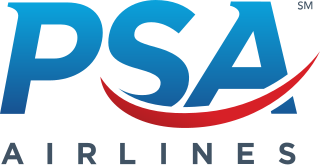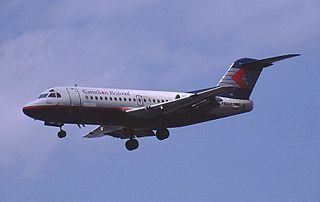United Express is the brand name for the regional branch of United Airlines, under which five individually owned regional airlines operate short- and medium-haul feeder flights.
Continental Express was the operating brand name used by a number of independently owned regional airlines providing commuter airliner and regional jet feeder service under agreement with Continental Airlines. In 2012 at the time of Continental's merger with United Airlines, two carriers were operating using the Continental Express brand name:
Canadian Airlines International Ltd. was a major Canadian airline that operated from 1987 until 2001. The airline was Canada's second largest airline after Air Canada, carrying more than 11.9 million passengers to over 160 destinations in 17 countries on five continents at its height in 1996. Canadian Airlines served 105 destinations in Canada, more than any other airline. Canadian Airlines was also a founding member of the Oneworld airline alliance.

Buffalo Niagara International Airport is in Cheektowaga, New York, United States. The airport serves Buffalo, New York and Niagara Falls, New York United States, and the southern Golden Horseshoe region of Ontario, Canada. It is the third-busiest airport in the state of New York and the busiest inside of the Buffalo-Niagara Falls metropolitan area. It is about 11 miles (18 km) east of Downtown Buffalo and 60 miles (97 km) southeast of Toronto. The airport covers 1,000 acres (400 ha).
US Airways Express was the brand name for the regional affiliate of US Airways, under which a number of individually owned commuter air carriers and regional airlines operate short and medium haul routes. This code sharing service was previously operated as USAir Express. Mainline carriers often outsource to regional airlines to operate services in order to increase frequency, serve routes that would not sustain larger aircraft, or for other competitive reasons. US Airways Express operations were conducted from smaller markets in the United States, Canada, and the Bahamas primarily centered on US Airways' major hubs and focus cities.

PSA Airlines is an American regional airline headquartered at Dayton International Airport in Dayton, Ohio, United States. The airline is a wholly owned subsidiary of the American Airlines Group and it is paid by fellow group member American Airlines to staff, operate and maintain aircraft used on American Eagle flights that are scheduled, marketed and sold by American Airlines.

A regional airline is a general classification of airline which typically operates scheduled passenger air service, using regional aircraft, between communities lacking sufficient demand or infrastructure to attract mainline flights. In North America, most regional airlines are classified as "fee-for-departure" carriers, operating their revenue flights as codeshare services contracted by one or more major airline partners. A number of regional airlines, particularly during the 1960s and 1970s, were classified as commuter airlines in the Official Airline Guide (OAG).
QuikAir was a small Canadian regional airline based in Calgary, Alberta, serving business travellers. QuikAir ceased its operations on October 24, 2006.

The Handley Page HP.137 Jetstream is a small twin-turboprop airliner, with a pressurised fuselage. The aircraft was designed to meet the requirements of the United States commuter and regional airline market. The design was later improved and built by British Aerospace as the BAe Jetstream 31 and BAe Jetstream 32, featuring different turboprop engines.
Trans States Airlines was a regional airline in the United States that operated from 1982 until 2020, when it shut down due to the COVID-19 pandemic. It was owned by Trans States Holdings and headquartered in Bridgeton, Missouri. At the time of its closing, the airline operated flights for United Airlines under the United Express brand. Trans States Airlines ceased all operations on April 1, 2020.

Canadian Regional Airlines was a regional airline headquartered in Calgary International Airport in Calgary, Alberta, Canada. It is now part of Air Canada Jazz.

Mid Pacific Air was a low-cost regional airline which began operations with passenger services in Hawaii. Founded in 1981, initial routes connected the islands of Kauai, O'ahu, Maui and Hawaii. Its primary competitors were established air carriers Hawaiian Airlines and Aloha Airlines. When it operated in the Midwest, its headquarters were on the grounds of Indianapolis International Airport in Indianapolis, Indiana. Originally its headquarters were located at Honolulu International Airport.

Reno Air was a scheduled passenger airline headquartered in Reno, Nevada, United States. Reno Air provided service from its hubs at Reno/Tahoe International Airport in Reno, Nevada, San Jose International Airport in San Jose, California and Las Vegas International Airport in Las Vegas, Nevada to destinations throughout the western United States, including Alaska. International service to Vancouver, British Columbia in western Canada was also served at one point and limited service was operated to the midwestern U.S. as well. A small stand alone operation was also undertaken at one point in the southeastern U.S. with the service being based in Gulfport, Mississippi. American Airlines acquired Reno Air in 1999.
StatesWest Airlines was a commuter airline headquartered in Phoenix, Arizona that operated to destinations in the Southwestern United States.

Metro Airlines, originally Houston Metro Airlines, was a commuter airline that was originally headquartered in Houston, Texas, United States,. Metro subsequently moved its headquarters to north Texas. The airline had an operational base located on the grounds of Dallas/Fort Worth International Airport and also had offices on the airport property and in Grapevine, Texas. Metro evolved into an airline holding company with the acquisition or creation of a number of different airlines, including as the banner carrier operating feeder services for Eastern Airlines as Eastern Metro Express which was based in Atlanta, GA and Metroflight which operated American Eagle service from the Dallas/Ft. Worth Airport. The company filed for bankruptcy in 1993, and the assets were acquired by AMR Simmons Airlines.

The British Aerospace Jetstream is a small twin turboprop airliner, with a pressurised fuselage, developed as the Jetstream 31 from the earlier Handley Page Jetstream. A larger version of the Jetstream was also manufactured, the British Aerospace Jetstream 41.

United Express Flight 6291 was a regularly scheduled United Express flight from Dulles International Airport near Washington, D.C. to Port Columbus International Airport in Columbus, Ohio. It was a service operated by Atlantic Coast Airlines on behalf of United Express.
Pem-air from was an aviation company based out of the Pembroke Airport.
American Eagle is a US brand name for the regional branch of American Airlines, under which six individual regional airlines operate short- and medium-haul feeder flights. Three of these airlines, Envoy Air, Piedmont Airlines, and PSA Airlines, are wholly owned subsidiaries of the American Airlines Group. American Eagle's largest hub is Charlotte Douglas International's Concourse E, which operates over 340 flights per day, making it the largest express flight operation in the world.
Air Toronto, previously Commuter Express, was a passenger airline based at Toronto Pearson International Airport. It primarily provided connector flights for passengers of Air Canada.










